
Do you think that keyword research is dead? Or do you believe that there is that keywords are no longer important in today’s SEO?
Thanks to the notion that Google has become smarter enough to understand the context of the content even it lacks keywords.
But keyword research is not dead.
Otherwise, keywords wouldn’t be the part of Google’s ranking factors.
They are one of the important building blocks of modern-day SEO.

BUT keywords strategy has changed a lot over the years, requiring new approaches to get ranked.
You cannot afford to stick to the same keyword practices you used to do in 2015.
If I were to create content on “keyword research topic” some 8-10 years back, it would be like…
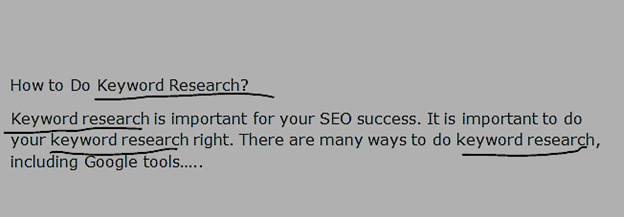
The excessive use of the same keywords in your title and content body used to be acceptable back then. Google used to serve this piece of content to those who were searching for keyword research.
But today, Google would adjudge such content a piece of spam and slash its ranking.
If you still stick to such keyword practices, no wonder why you are losing ranking or not seeing it at all.
This is because Google has become more user-oriented than ever before. It means that Google tries to understand the intent of the user in their queries.
Using keywords that exactly match a person’s search query is not that useful in today’s SEO.
Therefore, upgrade your keyword research strategy to improve your ranking.
How to Get Started with Your SEO Keyword Research Strategy?
Here I have come up with this Keyword Research Checklist that will help you cover all the points.
This checklist has been divided into four important steps:
- Finding and Mapping Keywords to Match Buyer’s Persona
- Prioritizing and Optimizing the Targeted Keywords
- Performing Keyword Ideation and Research
- Incorporating LSI Keywords

Image Source:Ndupress.ndu.edu
STEP 1: FINDING AND MAPPING KEYWORDS TO MATCH THE BUYER’S PERSONA
Today, keyword research is all about the topics people care about, how popular those topics are among your target audience. Those topics (keywords) are likely to get a high volume of searches per month. You need to identify and sort them. Simply put, it is all about what phrases people use to find your business.
Identify Your Buyer’s Journey:
The very first step of your SEO keyword research is to understand your customers or buyer persona.
To know your audience, ponder over these things…
Who are they? What do they do? What are their problems? What is their age group? What is their financial condition? How your product or services can solve their problems?
Let’s understand with an example.
Imagine you sell a skin cream for women, meaning that your target audience is women.
Now, your brainstorming session would be like that…
- Your skin cream is meant for which age group.
- What type of problem it can address?
- Is it safe for pregnant women?
- Is it fit for women working in the sun or harsh environment?
- Is it affordable?
Going through these basic considerations will give you an idea.
By this point, you must have a rough idea of your target audience and their needs.
Once you understand this, here are three important stages of a buyer’s journey to go through.
STAGE 1: AWARENESS: The buyer realizes they have a problem
STAGE 2: CONSIDERATION: The buyer performs research to know more about his problem and compares different solutions on the market.
STAGE 3: CONVERSION: The buyer looks to purchase the solution.
These four stages tell what a buyer is likely to go through before buying a product. At every stage, he or she will use different keywords. Yeah, the keywords would be different at every stage.
AND THIS IS WHERE YOUR KEYWORD RESEARCH STARTS.
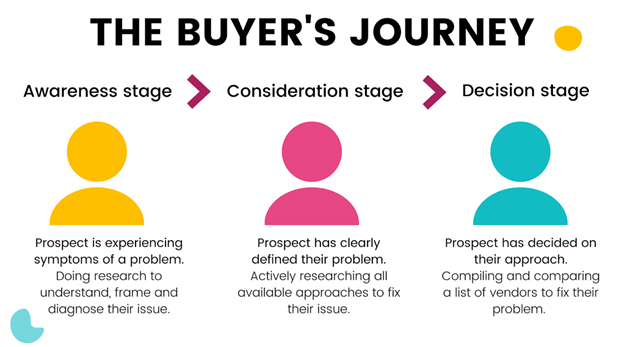
Image Source: noisylittlemonkey.com
Let’s understand it with a skincare business example.
The Buyer’s Journey for Skin Cream Purchase
| AWARENESS STAGE | CONSIDERATION STAGE | DECISION STAGE | |
| THOUGHT PROCESS | I have pimples | Best solution or cream to remove pimples | ABC Pimple Cream vs. Home Remedies |
| POSSIBLE SEARCH QUERIES | “pimple causes”
“pimple symptoms” “How to remove pimples” |
‘best pimple cream”
“herbal pimple cream” “pimple cream for summers” |
“ABC Pimple cream prices”
“Pimple cream in the budget” “best home remedies” |
The above table shows the types of queries or terms a customer is likely to use at different stages of their journey.
So you need to prepare keywords for all stages of the buyer’s journey of your target audience.
How to Create Content Map Based on the Keywords Obtained from Buyer’s Journey and Buyer’s Persona?
In this part, we will learn how to find keywords related to user intent across all parts of users’ journeys and create content accordingly.
Content Strategy for Awareness Stage:
This is the stage where visitors are still trying to define and understand their issues or requirements. Therefore, the content would be informational at this stage.
Moving with the example of skincare cream for acne, here is how content titles may look like:
- Types of acne and what might be causing them
- Top reasons why acne don’t go away
- Acne in summers.
Content Strategy for Consideration Stage (It’s Your Hook!)
At this stage, a customer is likely to research the causes and solutions for their problem. They are likely to research the products and compare them as well. But they are still not ready to buy. You need to convince them at this stage.
Here is how you can play smartly here by creating:
- Products comparison charts
- Expert guides
- White Papers
- Ebooks
- Videos
- Reviews
- Customer Testimonials
- FAQs
Create content that shows how your services or products can solve their problems. Here are some examples of creating content titles:
- Best Skin Creams for Acne
- Best in Pimple Care with Expert’s Choice
- How Our Acne Cream Can Help You
Content Strategy for Conversion Stage:
Finally, once a lead reaches the conversion stage, they are likely to make up their mind to buy. It is also the point where they want to know what it takes to become your customer. Create a direct approach with offers as indicated by the content types given below:
- Products specifications
- Competitor comparison
- Case Studies
- User Manual
- Demo or How it Works
- Instructional or DIY contents
Again, you need to find keywords for each stage.
STEP 2: Prioritize Your Targeted Keywords
The second step of the keyword research checklist includes optimizing your existing keywords as well as finding the keywords with potential.
This part includes three key points namely PROTECT, IMPROVE AND EXPAND.
Let’s understand each point in detail.
PROTECT:
This point is all about identifying the keywords you already rank for and intends to retain.
To find the keywords you rank for, you can visit Google Search Console (Performance—Queries).
The “Queries” tab will show you the keywords as you scroll. From there, you can see what keywords your pages rank for (click the “Pages” tab and then select the page you want to review.)
Now, visit the “Queries” tab again to see all of the keywords that the pages you have selected in the last step rank for.


There is also the graph of your performance report on the top where you can see total clicks (number of times a page is clicked), a total impression (number of times your results is shown in search), average CTR (the number of clicks divided by the number of impressions).
And then there comes the “Position” metrics to show where a page is ranked. If it is on the top, the position will be one. On having the top of page two, the position might be 11.
Once you identify your high-ranking keywords, you can create more content on them. However, it is equally important to understand the user intent.
IMPROVE:
In this step, we will review the keywords you are in striking distance of achieving.
What are striking keywords?
It refers to a keyword that is not at a top of Google SERPs yet, but with little effort and time could improve its ranking to the top spot. In other words, if your keyword is at the bottom of the 1st page, you can aim to get it to the top of the search results. But the same thing is not possible with the keywords ranking at the last search results pages. The ranking should be realistic and achievable. Basically, it is all about optimizing those keywords to help them reach the top spot.
How to Find Striking Distance Keywords?
You can use tools like SEM Rush to spot the keywords. For example, SEM Rush lets you sort keyword positions to be less than 30 and more than 10 to show a full list of current striking distance keywords. This will show the keywords that display on pages 2 and 3 of the SERPs.
Once you get a list of striking distance keywords, you can optimize them to improve their position.
How to Optimize Striking Distance Keywords?
- Create the content on these keywords
- Consider creating new landing pages on striking distance keywords.
- Internal linking to the pages that include striking distance keywords. For example, you can link your webpage mentioning a striking distance keyword named “SEO tips” to the phrase you have used somewhere across your website. To find that phrase, you can type site:yourdomain.com “SEO tips” in the Google search box.
- Optimize title tags and header tags.
STEP 3: KEYWORD IDEATION AND RESEARCH
This step is dedicated to finding keywords or search phrases used by people. Sure, you have keyword tools to perform keyword research. But it is still important to broaden your research to get the common search or similar phrases used by people.
Here’s how you can find those keywords:
Related Searches:
It appears as a box at the bottom of a search page. As the name suggests, this box contains the search queries related to your search term.
They offer you valuable insight into what people are searching for. Needless to say, you should consider those phrases and use them in your content.
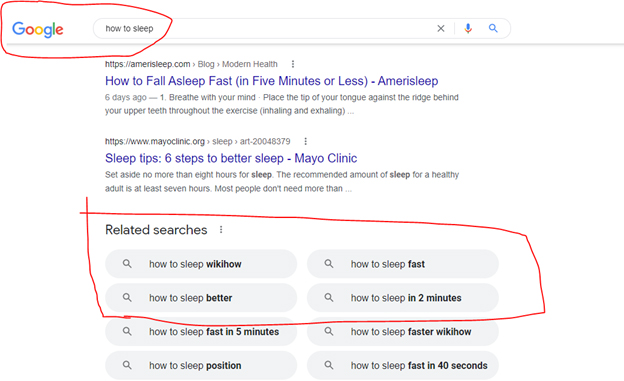
People Also Ask:
The “People Also Ask” box appears right at the starting of the page. It contains a set of questions related to the search query you have made. On clicking a question, the box expands to show a text snippet with a brief answer. It is also a great idea to find keywords to generate content.

Image source: Pursuitmag.com
Wikipedia:
Surprisingly, Wikipedia can be one of the holistic approaches to your keyword research.
One of the world’s biggest sources of information, Wikipedia includes some killer keyword ideas related to your genre.
To effectively use Wikipedia for keyword generation, follow the steps given below:
- Type your query along with Wikipedia in the search box. For example, I used the query “online marketing Wikipedia” and get the results as shown in the snapshot:
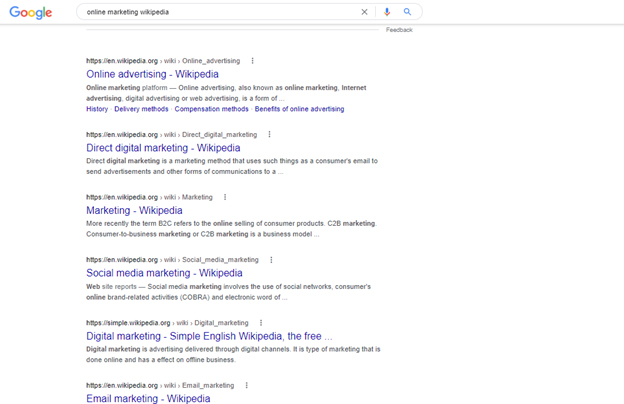
- Write down the keywords in bold that appeared in the SERPS, as I have picked online marketing, Internet advertising, and digital marketing to create keywords. These bold terms might not be keywords themselves, but they can show the specificity of keywords that you could be used to enhance your keyword strategy.
- Search keywords from Wikipedia itself for the rest of the research (in the very first paragraph). In the below-given snapshot, I have picked keywords like digital media, search engine marketing, content marketing, display advertising, and online marketing.
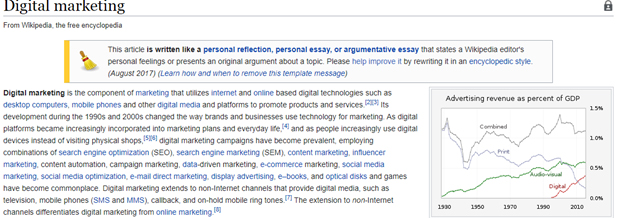
- Pick keywords from the Content section. Choose any of the relevant topics from there to locate the keywords

- Use the References Section for More Possibilities. The highlighted terms in the below-given screenshots can give you longtail or niche ideas for keywords your potential customers would be using.
 Perform Competitive Analysis:
Perform Competitive Analysis:
You can use Google Keyword Planner to see what keywords are being used by your competitors.
STEP 4: USING THE LSI KEYWORDS
LSI keywords help Google understand the context and content of your page.
But LSI keywords are not the synonym of your primary keyword.
Keep in mind that LSI keywords are supportive terms, not synonyms.
Let’s understand it with this example:
You have created a blog on “benefits of jogging”. While you can use synonyms of jogging such as running, but your LSI keywords would be the ones that can support your articles such as running shoes, cardio, running distance, and muscle recovery. Google will consider these terms to confirm that your page is all about jogging. Similarly, your LSI terms are likely to be glass, machine, grind, beans, water, drinks, recipes, filter, and ice for your cold coffee blog.
That’s why using LSI keywords in your content can boost your SEO.
How to Find LSI Keywords
- Look for the RELATED SEARCHES feature usually at the bottom of each SERP page.
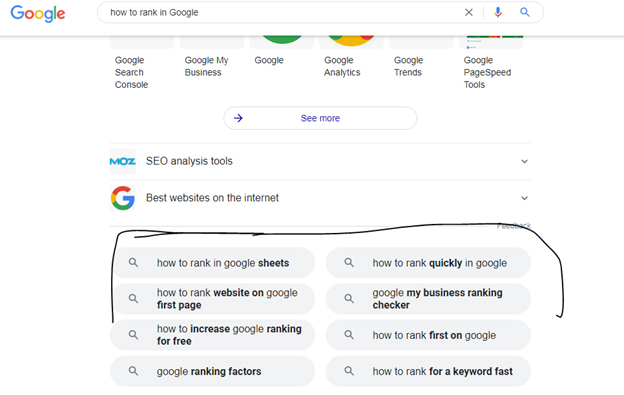
- Look at the phrase that shows up when you type a search query into the Google search bar.

- Use Google Keyword Planner:
- Use Tools like Lsigraph.com, Keys4up, Twinword Ideas LSI Graph, LSI Graph, Niche Laboratory, Semantic Link, LSI Keywords, Ultimate Keyword Hunter, Answer The Public
- Keyword Tool and KWFinder
The Bottom Line:
After going through the steps given above, you must have understood what it takes to generate and focus on the right keywords.
Like I said before, understand your target audience or customers first before getting started with keyword research. It will create a good groundwork as you get familiar with the possible search phrases used by them. Then, move to the tools to generate keywords. Apart from generating new keywords, you need to optimize the existing ones and check your important web pages for those keywords. Also, look for the new keywords or search phrases in the Related Search feature, Wikipedia, People Also Ask, and search terms showing up as you type. Last but not least, incorporate the LSI keywords that can support your primary keywords.
Again, the winning keywords are the ones that can help Google or any other search engine understand the context of your page efficiently. Enjoy!!!

Started working as a digital marketing expert, Varun Sharma is now also a well-known digital marketing speaker – a speaker on performance development, and a trusted mentor to businesses in the digital world. His keynote expositions are based on the digital marketing theories, which provide a fascinating insight into the secrets of high performance.

